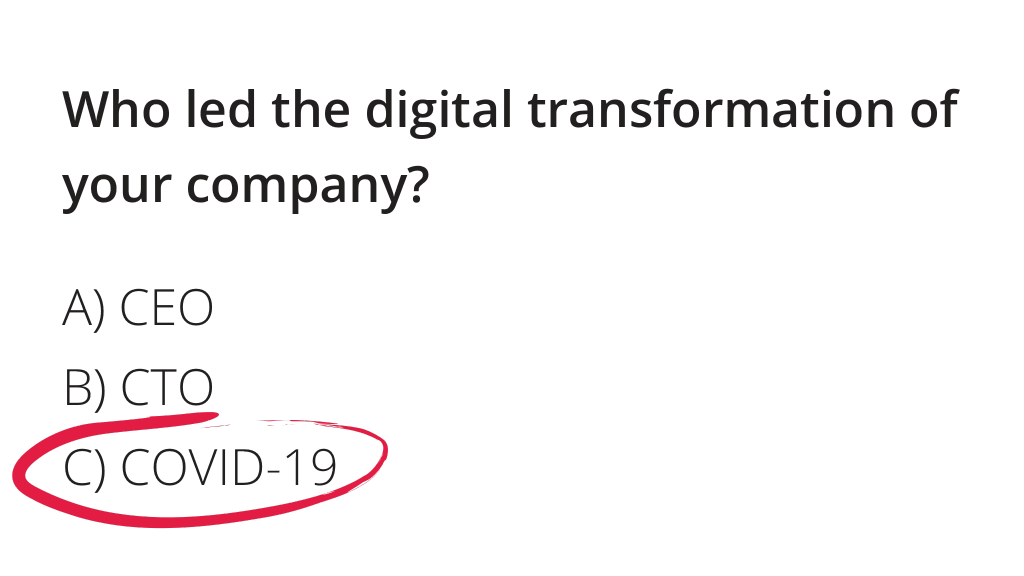Over the past years, digital transformation has picked up momentum. Many companies have embraced the change while others haven’t because they saw it as low-priority.
Today, COVID-19 is accelerating digital transformation processes at many companies, usually bumping against standing resistance, silos and mindsets. Instead of a prepared plan with an accurate analysis of resources and goals, Coronavirus is setting the agenda of priorities and where to focus digital transformation efforts.
Maybe there isn’t a more visual example of the situation we are living in, than an image floating around LinkedIn and Twitter asking people what inspired their digital transformation.

Rethink
Rather than run after their instinct, what companies need to be doing is asking themselves how this situation is impacting their industries, their business models and how they can continue delivering value to its customers in this new environment. After all, nobody can deny that nothing is going to be like it was before.
So, despite the challenges that transformation represents, there is a great opportunity behind all of this. No matter how mature your company is, the changing environment we’re living in forces us all to rethink the way we are adding value to our customers and to keep our businesses adaptive.
The business value of Digital Transformation
If we go back through the years, we’ll see that the most important peculiarity of societies is the capacity to remain adaptive. This idea could be perfectly applied to business, as well.
Companies are not alone – they are part of an environment where multiple actors have an impact and produce continuous changes. We can also affirm that societies who predict and anticipate these changes gain an advantage from others. The same goes for companies.
Hence, the importance of developing the capability of adaptation and the value of continuously analyzing what’s happening versus what we are doing. For many years now, digital transformation has stood as the process of change that can help businesses to stay relevant.
Sticking with traditional business models that no longer add value to users could be what puts your company out of business very quickly, even if you are a very established organization. Just look at cases such as Blockbuster, a company that went bankrupt after 6 years of achieving $6B in revenue.
So why would a large company like Blockbuster lose market share from small competitors (like Netflix was at the time)? Maybe the chief mistake of the video rental giant was being blinded by success and failing to concentrate on new opportunities or threats. From that, and thanks to the capability of being disruptive, Netflix took the advantage and changed the rules of the game.
But this is just a well-known example. There are many cases where smaller, faster and more agile companies thrive against their bigger competitors because they were focused on meeting user’s needs.
It’s about a radical change in the company mindset, reinventing what you’ve been doing to meet market demands, even when it means changing the company vision. And as part of that change, companies need to put the user at the center.
When Amazon came on the scene, it caused a boom in the retail world and many companies were forced to rethink their business because they had no choice. Similarly, Best Buy reinvented their vision and instead of just selling products, they turned their efforts to enrich people’s lives with technology. The company was able to reconfigure its business operation in a way that created competitive advantages for its business and added value to their customers.
What’s really interesting about the Best Buy transformation case, is how its CEO at that time – Hubert Joly– took advantage of what the firm could offer that the competitors did not, and built a business strategy around it. He envisioned a scenery where the company blended the human, the physical, and the digital in ways that an online-only player would find tough to do, always thinking about how to create a good customer experience.
What I am trying to say is that there is nothing that can guarantee your business stays at the top. You must embrace innovation and digital transformation at the core of your business. There is no other option if you want to survive.
In light of these facts, there is no reason to deny the importance of embracing a well-planned digital transformation process. Even when it’s not easy and requires enormous efforts, the rewards could be huge, especially later on once you’ve embraced digitization entirely and given new business models and tools the time to take effect.
It’s about more than resources
As in the David and Goliath story, it is not about how big you are, but how you take advantage of the resources you have. You have to have the right mindset to see the opportunities around you.
There were cases like Blockbuster but there were others, too. They were able to detect their business’ weaknesses and embark upon a digital transformation process. However, they too failed in the way because they were not focused on what matters the most: culture.
One of the common mistakes in digital transformation is to see it as a mere technological process when what it really is, is the adoption of a mindset toward the customer. Together with your culture, your business model must change too. If your company is not able to embrace a user-oriented mindset, the chances of failure will increase. And without a strong organizational culture to reinforce your digital transformation goal, your transformation is unlikely to make it off the ground.
As Brian Chesky, Co-founder, and CEO of Airbnb, says: “A company’s culture is the foundation for future innovation”
A changing game
The way you do things today probably won’t be appropriate in the future. As the world is changing, markets and users’ needs and behaviors change too, and what has been your most valuable proposition for years, could be nothing years later.
Across the years we have been helping companies in several industries to thrive in what I like to call the user-centric era and as a result, we can see how they are boosting their business outcomes, reaching new markets, and increasing their valuation.
Digital transformation it’s not just about adopting a bit of technology here and there throughout the company. It’s a cultural revolution and a process that should never end. Embrace it, and keep your business on track – this is our advice.
